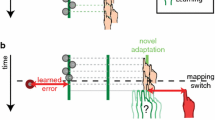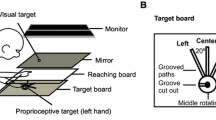Abstract
In two experiments we studied the role of active movements for adaptation to a visuo-motor rotation by way of adding external forces. In the first experiment we compared practice with target guidance and path guidance with a no-guidance control condition. With target guidance the arm was driven to the target on a straight path, whereas with path guidance active movements were required which were driven to the correct straight path of the hand whenever there was a deviation. During practice target guidance resulted in faster movements with smaller initial direction errors than in the other two conditions. However, in subsequent visual open-loop tests the adaptive shifts turned out to be smaller after both target-guidance and path-guidance practice than after no-guidance practice. In the second experiment resistive path guidance during practice was compared with a no-guidance control condition. With resistive path guidance the hand was driven away from the correct straight path whenever there was a deviation. Thus, corrections required active movements and could not be passive as with assistive path guidance in the first experiment. During practice resistive path guidance resulted in longer movement time than in the no-guidance group. Adaptive shifts, as assessed in subsequent open-loop tests, were not different between the two groups. According to these findings adaptation to a visuo-motor rotation is driven by active error corrections.





Similar content being viewed by others
References
Abeele S, Bock O (2001a) Mechanisms for sensorimotor adaptation to rotated visual input. Exp Brain Res 139:248–253
Abeele S, Bock O (2001b) Sensorimotor adaptation to rotated visual input: different mechanisms for small versus large rotations. Exp Brain Res 140:407–410
Abeele S, Bock O (2003) Transfer of sensorimotor adaptation between different movement categories. Exp Brain Res 148:128–132
Adams JA (1971) A closed-loop theory of motor learning. J Mot Behav 3:111–155
Andersen RA, Snyder LH, Bradley DC, Xing J (1997) Multimodal representation of space in the posterior parietal cortex and its use in planning movements. Ann Rev Neurosci 20:303–330
Baily JS (1972) Adaptation to prisms: do proprioceptive changes mediate adapted behavior without ballistic arm movements? Quart J Exp Psychol 24:8–20
Bedford FL (1993) Perceptual and cognitive spatial learning. J Exp Psychol Hum Percept Perform 19:517–530
Bedford FL (1995) Constraints on perceptual learning: objects and dimensions. Cognition 54:253–297
Buch ER, Young S, Contreras-Vidal JL (2003) Visuomotor adaptation in normal aging. Learn Mem 10:55–63
Burdet E, Osu R, Franklin DW, Milner TE, Kawato M (2001) The central nervous system stabilizes unstable dynamics by learning optimal impedance. Nature 414:446–449
Cesqui B, Aliboni S, Mazzoleni S, Carrozza MC, Posteraro F, Micera S (2009) On the use of divergent force fields in robot-mediated neurorehabilitation. In: Biomedical robotics and biomechatronics, BioRob 2008. IEEE, Scottsdale, AZ, pp 854–861. doi:10.1109/BIOROB.2008.4762927
Clower DM, Boussaoud D (2000) Selective use of perceptual recalibration versus visuomotor skill acquisition. J Neurophysiol 84:2703–2708
Coren S (1966) Adaptation to prismatic displacement as a function of the amount of available information. Psychon Sci 4:407–408
Cunningham HA (1989) Aiming error under transformed spatial mappings suggests a structure for visual-motor maps. J Exp Psychol Hum Percept Perform 15:493–506
Feygin D, Keehner M, Tendick F (2002) Haptic guidance: experimental evaluation of a haptic training method for a perceptual motor skill. In: Proceedings of the 10th international symposium on haptic interfaces for virtual environment and teleoperator system (Haptics 2002). IEEE computer society, Orlando, pp 40–47
Franklin DW, Liaw G, Milner TE, Osu R, Burdet E, Kawato M (2007) Endpoint stiffness of the arm is directionally tuned to instability in the environment. J Neurosci 27:7705–7716
Ghilardi MF, Gordon J, Ghez C (1995) Learning a visuomotor transformation in a local area of work space produces directional biases in other areas. J Neurophysiol 73:2535–2539
Guedon O, Gauthier G, Cole J, Vercher J-L, Blouin J (1998) Adaptation in visuomotor tracking depends on intact proprioception. J Mot Behav 30:234–248
Held R, Hein A (1958) Adaptation to disarranged hand-eye coordination contigent upon reafferent stimulation. Percept Mot Skills 8:87–90
Heuer H, Hegele M (2008) Adaptation to direction-dependent visuo-motor rotations and its decay in younger and older adults. Acta Psychol 127:369–381
Heuer H, Hegele M, Sülzenbrück S (in press) Implicit and explicit adjustments to extrinsic visuo-motor transformations and their age-related changes. Hum Mov Sci. doi:10.1016/j.humov.2010.07.004
Ingram HA, van Donkelaar P, Cole J, Vercher J-L, Gauthier GM, Miall RC (2000) The role of proprioception and attention in a visuomotor adaptation task. Exp Brain Res 132:114–126
Keele SW, Ivry RB, Mayr U, Hazeltine E, Heuer H (2003) The cognitive and neural architecture of sequence representation. Psychol Rev 110:316–339
Kitazawa S, Kimura T, Uka T (1997) Prism adaptation of reaching movements: specificity for the velocity of reaching. J Neurosci 17:1481–1492
Krakauer JW, Pine ZM, Ghilardi MF, Ghez C (2000) Learning of visuomotor transformations for vectorial planning of reaching trajectories. J Neurosci 20:8916–8924
Mazzoni P, Krakauer JW (2006) An implicit plan overrides an explicit strategy during visuomotor adaptation. J Neurosci 26:3642–3645
Pipereit K, Bock O, Vercher J-L (2006) The contribution of proprioceptive feedback to sensorimotor adaptation. Exp Brain Res 174:45–52
Reinkensmeyer DJ, Patton JL (2009) Can robots help the learning of skilled actions? Exerc Sport Sci Rev 37:43–51
Saijo N, Gomi H (2010) Multiple motor learning strategies in visuomotor rotation. PLoS ONE 5(2):e9399
Schmidt RA, Lee T (1999) Motor control and learning: a behavioral emphasis, 3rd edn. Human Kinetics Publishers, Champaign
Schmidtke V, Heuer H (1997) Task integration as a factor in secondary-task effects on sequence learning. Psychol Res 60:53–71
Shadmehr R, Smith MA, Krakauer JW (2010) Error correction, sensory prediction, and adaptation in motor control. Annu Rev Neurosci 33:89–108
Sülzenbrück S, Heuer H (2009) Functional independence of explicit and implicit motor adjustments. Conscious Cogn 18:145–159
Taylor JA, Ivry RB (2011) Flexible cognitive strategies during motor learning. PloS Comput Biol 7(3):e1001096
Welch RB (1972) The effect of experienced limb identity upon adaptation to simulated displacement of the visual field. Percept Psychophys 12:453–456
Welch RB (1974) Research on adaptation to rearranged vision : 1966–1974. Perception 3:367–392
Welch RB, Rhoades RW (1969) The manipulation of informational feedback and its effects upon prism adaptation. Can J Psychol 23:415–428
Wolpert DM, Kawato M (1998) Multiple paired forward and inverse models for motor control. Neural Netw 11:1317–1329
Acknowledgments
The research reported in this paper was supported by the European Community’s Seventh Framework Programme, Grant Agreement Number 231724 (HUMOUR). We thank Johanna Maag, Tuğba Özcan, and Philipp Quiring for their support in running the experiments.
Author information
Authors and Affiliations
Corresponding author
Rights and permissions
About this article
Cite this article
Heuer, H., Rapp, K. Active error corrections enhance adaptation to a visuo-motor rotation. Exp Brain Res 211, 97–108 (2011). https://doi.org/10.1007/s00221-011-2656-5
Received:
Accepted:
Published:
Issue Date:
DOI: https://doi.org/10.1007/s00221-011-2656-5




